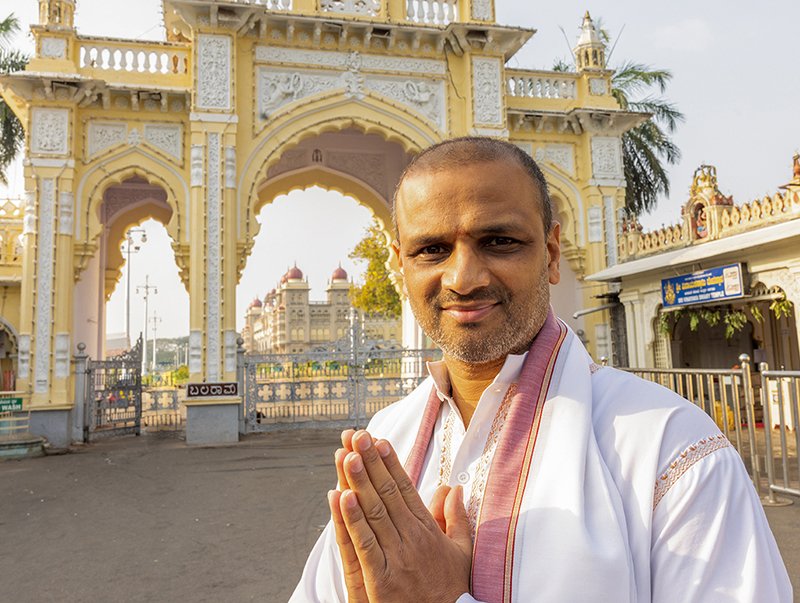In the Yoga Sutras, Patanjali defines the eight limbs of Aṣṭāṅga yoga that help one reach the “state” of yoga. The second limb is niyama, which can be translated to mean “personal observances.” Like the yamas, the practice of the niyamas is a way to help bring the mind into a state of balance for the purpose of yoga. While the yamas relate more to our interactions with the external world, the focus of the niyamas is more internal. The practices support connecting to the jivātman (soul) and Paramātman (supreme soul).
The Hatha Yoga Pradipika and Yoga Yajñavalkya list 10 niyamas, which are also mentioned by Krishnamacharya in his Yoga Makaranda. Below are brief descriptions of these 10 niyamas.
1. Tapas is the effort that is required to bring about our personal transformation in yoga practice. It is also the effort required in adhering to one’s dharma. Dharma here refers to the duties that we need to do in relation to our position within our families, communities, and society. Traditionally, these included spiritual duties that were performed for the good of all. The word tapas can also be translated as heat, penance, or austerity, and implies that we apply continuous and focused effort in the direction of yoga. Without this focus, we are unlikely to progress.
2. Saṃtoṣa can be translated as cultivating a feeling of contentment in all aspects of life, regardless of the situation in which we find ourselves. Cultivating saṃtoṣa allows us to overcome many of the negative emotions that may otherwise impede our progress. This requires the effort of tapas, and will reach its fullest expression by following all 10 niyamas.
3. Āstikya. Krishnamacharya defines āstikya as deep faith and firm conviction in the Paramātman (supreme soul). It is very much like Īśvarapraṇidhāna (intense devotion to Īsvara) mentioned in Patañjali’s Yoga Sutras. Patañjali does not define Īśvara as a particular deity such as Śiva or Viśṇu, as these are all expressions of the same higher reality. Instead, he describes Īśvara as the source of all knowledge, without any reservoir of previous karma, untouched by any afflictions—the “guru for all gurus”.
For those who do not follow any particular spiritual path, āstikya is the cultivation of faith and devotion to a higher power with these characteristics. The existence of Īśvara is central to the philosophy of yoga outlined by Patañjali in his Yoga Sutras. And Krishnamacharya says in Yogavalli, his commentary on the first chapter of the Yoga Sutras, that Īśvarapraṇidhāna, or devotion, to Īśvara is essential to making progress in yoga.
Related: Finding Community Outside of Religion
4. Dānam is generosity or charity. It is the distribution to others of that which is gained through honest means, without any expectation of return (including the expectation of recognition). This is considered a very important upāya (method) for atoning for past karma and for the removal of impediments to spiritual progress.
5. Īśvarapūjanam is the worship or veneration of Īśvara. While āstikya means cultivation of faith in the existence of a higher power, Īśvarapūjanam refers to the act of worship. On a basic level, this can mean the performance of devotional rituals. At a higher level, when we recognize that there is a higher power behind everything, we can bring devotion to all aspects of life. Performing dānam (charity) with the attitude that we are serving the divine within those who receive our charity helps prevent the onset of pride and brings even greater transformational power to those actions, which now contain the essence of worship.
6. Siddhānta-vākya-śravaṇam means listening to the established doctrine on philosophical and spiritual texts, in this case related to the yoga system. For instance, studying texts such as Patañjali’s Yoga Sūtras and listening to discourses on the sutras is considered an important aspect of yoga practice. These texts should be studied with a knowledgeable teacher who has gained experiential knowledge of yoga philosophy through his or her practice. This helps us to gain perspective in our yoga practice so that we can pursue it in a meaningful way.
Krishnamacharya also mentions that siddhānta-vākya-śravaṇam “is practiced to know the secret of Dharma and often remind[s] ourselves of the good advice given by great people.” The Vedas, Ramayana, Mahabharata, Bhagavad Gita, and Bhagavata Purana are texts filled with stories that are both enlightening and inspirational for deepening our understanding of spiritual matters related to yoga.
7. Hṛī. The Monier Williams Sanskrit Dictionary defines hrī as “shame, modesty, shyness, or timidity.” In yoga, hrī can be best defined as humility. Without hrī, the ego increases and the attitude that “I know” becomes dominant, leading us to be less receptive to new ways of understanding. On the other hand, an attitude of humility results in an openness that is conducive to learning. The yogic mind has to become fresh like a child’s mind, able to see things clearly and in new ways that may challenge our previously held beliefs. In yoga and in all spiritual disciplines, this is extremely important for the purpose of spiritual growth.
Related: The Importance of Humility in Athletics
8. Matī means a discerning intellect. We should develop the capacity for spiritual discernment (viveka), which is the ability to differentiate between our spirit or soul (ātman) and the phenomenal world (prakṛti). Matī is also the ability to judge situations clearly and insightfully. The practice of the first four limbs of Aṣṭāṅga yoga (yama, niyama, āsana, and prāṇāyāma) brings about the conditions under which matī can begin to develop. It also follows that matī builds on the previous niyamas. In particular, matī becomes far more powerful when coupled with hrī.
9. Japa means continuous repetition of mantras. The best-known mantra is the sacred syllable Oṃ. Patañjali states that Oṃ is the word which is an expression for Īśvara. He says that we should perform japa with meditation on its meaning in order to reveal the “pure consciousness” within, as well as for the removal of all obstacles to yoga. It is said that mantra should only be taught directly to a student by a teacher who has mastered and understood the mantra, otherwise there will be no effect. Mantra japa is extremely powerful and should be approached with great respect and humility.
10. Hutam or homa means the performance of special ritual actions outlined in the Vedas. These are relevant for those who follow Vedic traditions, but for those outside of these traditions, hutam can also refer to internal sacrifice. The idea of internal sacrifice is presented in the third chapter of the Bhagavad Gītā where Krishna states:
“Yajñārthātkarmaṇo’nyatra loko’yaṃ karmabandhanaḥ. tadarthaṃ karma kaunteya muktasaṅgaḥ samācara.” (“This world is bound by action, except those actions which are sacrificed to the Supreme. Oh Arjuna, perform all actions perfectly, free from attachment, for the purpose of sacrifice alone.”)
And in chapter five, Krishna says:
“Yuktaḥ karmaphalaṃ tyaktvā śāntimāpnoti naiśtikīm, ayuktaḥ kāmakāreṇa phale sakto nibadhyate.” (“The karma-yogin attains peace of mind when he abandons the fruit of his actions, while one who does not know yoga, clinging to the results of action, becomes forever bound.”)
Taken together, these two ślokas tell us to surrender our ego and perform all our actions for the good of the world. We should maintain an attitude that everything we do is done for a higher purpose and as an offering to the Supreme. We should attempt to do our very best but without any expectation of recognition or return from our actions. This kind of wisdom put into action requires a highly discriminating intellect (matī) coupled with great humility (hrī). When done perfectly, hutaṃ contains the elements of all the preceding niyamas.











Comments (0)